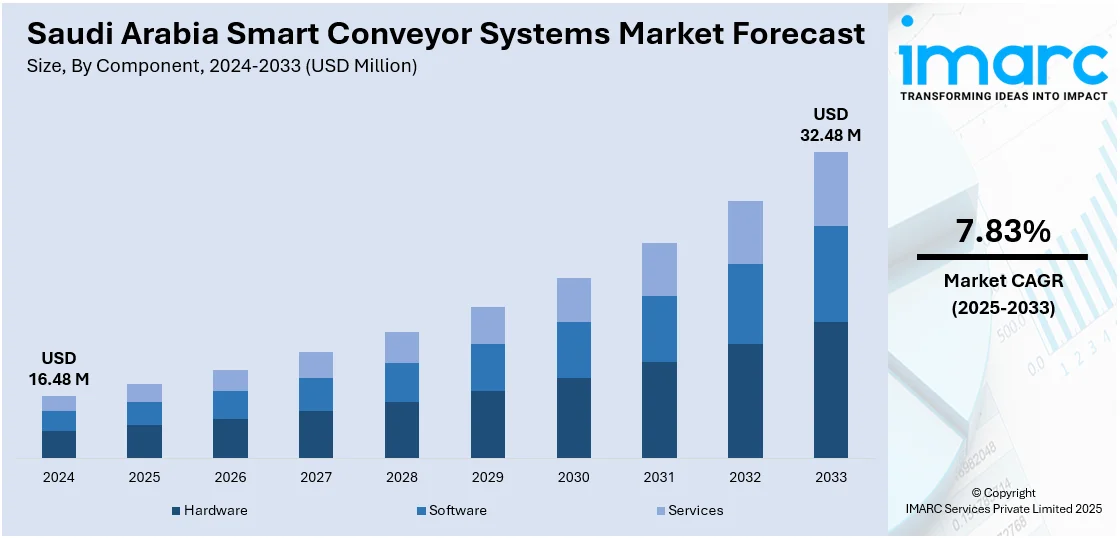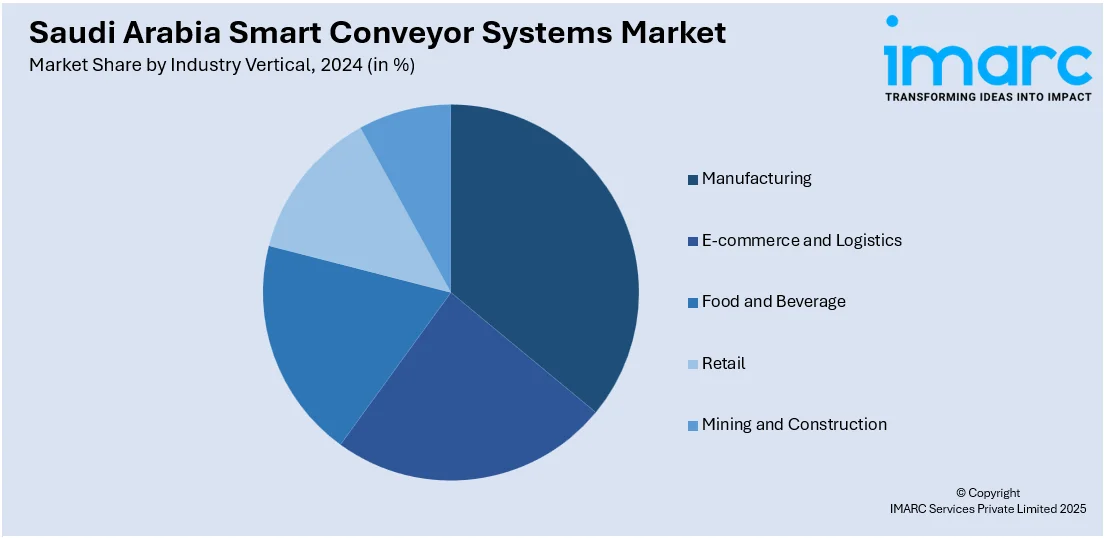
Saudi Arabia Smart Conveyor Systems Market Size, Share, Trends and Forecast by Component, Product Type, Technology, Automation Level, Industry Vertical, and Region, 2025-2033
Saudi Arabia Smart Conveyor Systems Market Overview:
The Saudi Arabia smart conveyor systems market size reached USD 16.48 Million in 2024. Looking forward, IMARC Group expects the market to reach USD 32.48 Million by 2033, exhibiting a growth rate (CAGR) of 7.83% during 2025-2033. The market is expanding due to strong logistics infrastructure growth and the rise of intelligent warehousing. Companies are prioritizing high-throughput, automated material handling to enhance speed, accuracy, and space efficiency. Additionally, the increasing use of digital twin and simulation technologies is enabling better planning, testing, and optimization of conveyor operations. These systems are becoming central to digitally-driven industrial strategies, offering adaptability, real-time insights, and seamless integration into advanced, data-centric operational environments. These factors are collectively contributing to the expansion of Saudi Arabia smart conveyor systems market share.
|
Report Attribute
|
Key Statistics
|
|---|---|
|
Base Year
|
2024 |
|
Forecast Years
|
2025-2033
|
|
Historical Years
|
2019-2024
|
| Market Size in 2024 | USD 16.48 Million |
| Market Forecast in 2033 | USD 32.48 Million |
| Market Growth Rate 2025-2033 | 7.83% |
Saudi Arabia Smart Conveyor Systems Market Trends:
Growing Investment in Intralogistics and Infrastructure
Saudi Arabia smart conveyor systems market growth is driven by increased investments in logistics and infrastructure from both public and private sectors. Extensive projects, such as manufacturing cities, economic zones, and distribution centers, are being implemented as a part of national transformation efforts, generating significant demand for smart material handling technologies. These facilities are progressively needing sophisticated conveyor systems to handle high-volume, high-precision tasks while maximizing space, especially in automated and multi-tiered warehouses. Intralogistics is emerging as a key strategic priority, with companies seeking to enhance speed, precision, and scalability throughout their supply chains. Smart conveyors facilitate smooth coordination of product transport, sorting, and storage, making them essential for meeting contemporary logistics requirements. The momentum was highlighted in 2024 when Saudi Arabia announced a $267 billion investment strategy for its logistics industry at the Global Logistics Forum in Riyadh. The strategy, in line with Vision 2030, aimed to establish the Kingdom as a key logistics hub connecting Asia, Europe, and Africa. In line with this commitment, SR200 billion had been allocated for enhancing transport corridors, modernizing supply chain infrastructure, and encouraging private involvement. These improvements are hastening the implementation of intelligent logistics systems at new distribution hubs and fulfillment centers. As the industry develops, companies are seeing smart conveyors not just as automation instruments, but as essential infrastructure for enduring logistics competitiveness.

Adoption of Digital Twins and Simulation Tools
Saudi Arabia is experiencing a rapid increase in the use of digital twin technology and simulation platforms in the industrial and logistics sectors, greatly impacting the implementation of smart conveyor systems. These digital tools enable operators to simulate, examine, and enhance conveyor performance prior to actual installation, minimizing commissioning duration and guaranteeing accurate alignment with operational requirements. Smart conveyors are progressively designed to facilitate this integration, allowing for simulations of load patterns, maintenance schedules, and throughput fluctuations. This enables system-wide modifications beforehand, reducing delays and budget overruns during implementation. In greenfield initiatives, where precise design from the outset is essential, digital twins are increasingly adopted as standard tools to minimize risk and improve transparency throughout the asset lifecycle. The increasing dependence on this technology is apparent from the growth of the Saudi digital twin market, which hit USD 217.2 million in 2024. As per forecasts by IMARC Group, the market is anticipated to grow to USD 15,749.6 million by 2033, demonstrating a remarkable CAGR of 61% from 2025 to 2033. This expansion emphasizes the strategic transition to virtual-first infrastructure planning across various sectors. As digital twins are increasingly integrated into operational planning, intelligent conveyors that enable real-time data sharing, adaptive reactions, and closed-loop feedback are highly favored. Their alignment with predictive modeling frameworks renders them crucial for contemporary industrial ecosystems that emphasize precision, agility, and resilience from the foundation.
Saudi Arabia Smart Conveyor Systems Market Segmentation:
IMARC Group provides an analysis of the key trends in each segment of the market, along with forecasts at the country and regional levels for 2025-2033. Our report has categorized the market based on component, product type, technology, automation level, and industry vertical.
Component Insights:
- Hardware
- Software
- Services
The report has provided a detailed breakup and analysis of the market based on the component. This includes hardware, software, and services.
Product Type Insights:
- Belt Conveyors
- Roller Conveyors
- Overhead Conveyors
- Pallet Conveyors
- Sortation Systems
A detailed breakup and analysis of the market based on the product type have also been provided in the report. This includes belt conveyors, roller conveyors, overhead conveyors, pallet conveyors, and sortation systems.
Technology Insights:
- IoT-Enabled Conveyors
- AI-Driven Systems
- Robotic Integration
- RFID and Barcode Scanning
The report has provided a detailed breakup and analysis of the market based on the technology. This includes IoT-enabled conveyors, AI-driven systems, robotic integration, and RFID and barcode scanning.
Automation Level Insights:
- Semi-Automated Conveyor Systems
- Fully Automated Conveyor Systems
A detailed breakup and analysis of the market based on the automation level have also been provided in the report. This includes semi-automated conveyor systems and fully automated conveyor systems.
Industry Vertical Insights:

- Manufacturing
- E-commerce and Logistics
- Food and Beverage
- Retail
- Mining and Construction
A detailed breakup and analysis of the market based on the industry vertical have also been provided in the report. This includes manufacturing, e-commerce and logistics, food and beverage, retail, and mining and construction.
Regional Insights:
- Northern and Central Region
- Western Region
- Eastern Region
- Southern Region
The report has also provided a comprehensive analysis of all the major regional markets, which include Northern and Central Region, Western Region, Eastern Region, and Southern Region.
Competitive Landscape:
The market research report has also provided a comprehensive analysis of the competitive landscape. Competitive analysis such as market structure, key player positioning, top winning strategies, competitive dashboard, and company evaluation quadrant has been covered in the report. Also, detailed profiles of all major companies have been provided.
Saudi Arabia Smart Conveyor Systems Market News:
- In August 2024, Savoye participated in the Saudi Warehousing & Logistics Expo (Sep 2–4), where it presented advanced logistics solutions, including conveyors, goods-to-person systems, and automation software. These innovations aimed to boost efficiency in Saudi Arabia’s fast-growing logistics sector. Target industries included retail, eCommerce, pharma, and grocery.
Saudi Arabia Smart Conveyor Systems Market Report Coverage:
| Report Features | Details |
|---|---|
| Base Year of the Analysis | 2024 |
| Historical Period | 2019-2024 |
| Forecast Period | 2025-2033 |
| Units | Million USD |
| Scope of the Report |
Exploration of Historical Trends and Market Outlook, Industry Catalysts and Challenges, Segment-Wise Historical and Future Market Assessment:
|
| Components Covered | Hardware, Software, Services |
| Product Types Covered | Belt Conveyors, Roller Conveyors, Overhead Conveyors, Pallet Conveyors, Sortation Systems |
| Technologies Covered | IoT-Enabled Conveyors, AI-Driven Systems, Robotic Integration, RFID and Barcode Scanning |
| Automation Levels Covered | Semi-Automated Conveyor Systems, Fully Automated Conveyor Systems |
| Industry Verticals Covered | Manufacturing, E-commerce and Logistics, Food and Beverage, Retail, Mining and Construction |
| Regions Covered | Northern and Central Region, Western Region, Eastern Region, Southern Region |
| Customization Scope | 10% Free Customization |
| Post-Sale Analyst Support | 10-12 Weeks |
| Delivery Format | PDF and Excel through Email (We can also provide the editable version of the report in PPT/Word format on special request) |
Key Questions Answered in This Report:
- How has the Saudi Arabia smart conveyor systems market performed so far and how will it perform in the coming years?
- What is the breakup of the Saudi Arabia smart conveyor systems market on the basis of components?
- What is the breakup of the Saudi Arabia smart conveyor systems market on the basis of product type?
- What is the breakup of the Saudi Arabia smart conveyor systems market on the basis of technology?
- What is the breakup of the Saudi Arabia smart conveyor systems market on the basis of automation level?
- What is the breakup of the Saudi Arabia smart conveyor systems market on the basis of industry vertical?
- What is the breakup of the Saudi Arabia smart conveyor systems market on the basis of region?
- What are the various stages in the value chain of the Saudi Arabia smart conveyor systems market?
- What are the key driving factors and challenges in the Saudi Arabia smart conveyor systems market?
- What is the structure of the Saudi Arabia smart conveyor systems market and who are the key players?
- What is the degree of competition in the Saudi Arabia smart conveyor systems market?
Key Benefits for Stakeholders:
- IMARC’s industry report offers a comprehensive quantitative analysis of various market segments, historical and current market trends, market forecasts, and dynamics of the Saudi Arabia smart conveyor systems market from 2019-2033.
- The research report provides the latest information on the market drivers, challenges, and opportunities in the Saudi Arabia smart conveyor systems market.
- Porter's five forces analysis assist stakeholders in assessing the impact of new entrants, competitive rivalry, supplier power, buyer power, and the threat of substitution. It helps stakeholders to analyze the level of competition within the Saudi Arabia smart conveyor systems industry and its attractiveness.
- Competitive landscape allows stakeholders to understand their competitive environment and provides an insight into the current positions of key players in the market.
Need more help?
- Speak to our experienced analysts for insights on the current market scenarios.
- Include additional segments and countries to customize the report as per your requirement.
- Gain an unparalleled competitive advantage in your domain by understanding how to utilize the report and positively impacting your operations and revenue.
- For further assistance, please connect with our analysts.
 Request Customization
Request Customization
 Speak to an Analyst
Speak to an Analyst
 Request Brochure
Request Brochure
 Inquire Before Buying
Inquire Before Buying




.webp)




.webp)












